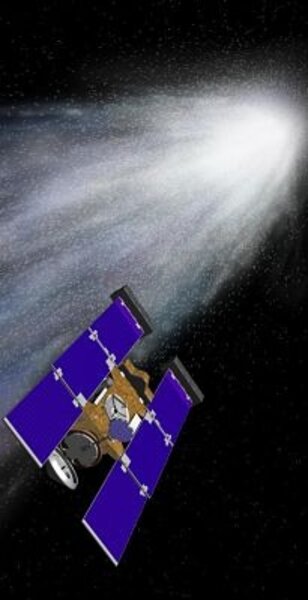Scientists find a building block for life in a comet's halo
Loading...
Life -- at least in simple forms -- may be quite common around the cosmos, if new results from NASA's Stardust mission are any indication.
Researchers have discovered glycine molecules in samples of cometary material the Stardust spacecraft returned to Earth after its encounter with comet 81P/Wild 2 in 2004.
Glycine is a simple amino acid. It provides the foundation around which other biologically important molecules are built -- including proteins and key components of DNA and RNA.
The discovery "supports the theory that some of life's ingredients formed in space and were delivered to Earth long ago by meteors and comets," notes Jamie Elsila, a researcher with NASA's Goddard Space Flight Institute in Greenbelt, Md.
He and his colleagues reported the results at this week's meeting of the American Chemical Society and a formal report on the work has been accepted for publication in the journal Meteoritics and Planetary Science. You can also find a plain-English version here.
Comets are lumps of ice, rock, and dust several kilometers across that are thought to represent some of the most primitive building blocks for what would become planets and moons. They grow out of the same large cloud of interstellar dust, ice, and gas that spawned the stars they orbit.
Comet Wild 2 was discovered in 1978 after a close encounter with Jupiter in 1974 shifted its orbit. Before the comet felt Jupiter's tug, it spent more than 4 billion years orbiting the sun once every 43 years. Now it swings around the sun in a much more elliptical orbit once ever six years.
Grabbing the samples
The glycine molecules that Stardust found came from gas the comet released as the sun warmed it. It was captured in the spacecraft's sampling gear -- akin to an oversized circular ice-cube tray filled with aerogel, a remarkably spongy material that can withstand high heat while at the same time slowing, then cradling, comet material that zips into it at faster-than-bullet speeds.
Stardust passed through the comet's coma -- a halo of dust and gas that surrounds the comet's core. The team found glycine in the aerogel as well as on some of the foil that lines the aerogel-filled collection chambers.
But the researchers still had to rule out possible contamination from Earth. Glycine consists of carbon, hydrogen, nitrogen, and oxygen. By analyzing the forms of carbon in the glycine molecules, they found that the samples had much higher proportions of a heavy isotope of carbon than does glycine on Earth. The verdict: It's extraterrestrial, born and bred on the comet itself.
Interstellar recipe for glycine
How might glycine form on a comet? Researchers in South Korea showed how it might happen, via lab experiments. Take some water ice. Add carbon dioxide. Throw in a dash of methylamine, an ammonia-like compound found as grains in the dust and gas between stars. Then subject the mixture to ultraviolet radiation at about the intensity you'd expect to see in interstellar space. Violà! Glycine.
The Korean team also found that while glycine can be destroyed by the same process that formed it, the cycle can reach a balance that allows glycine to be carried along through interstellar space. One could imagine that same process taking place on a comet hurtling around a star.
The team published its results in May in the Astrophysical Journal.





